27 Climate change
Deals with the potential impacts in Europe of the
enhanced greenhouse effect caused by a rise in CO2 levels in the
atmosphere, which is already 50% more than in pre-industrial times. The
chapter discusses the causes of the problem, the consequences (in terms
of changed climatic patterns, sea level rise, effects on hydrology,
threats to ecosystems and land degradation), and the international
strategies being used to try to limit temperature rises.
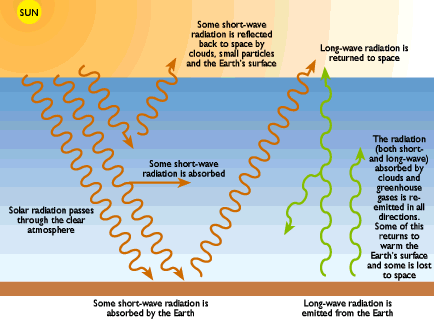
The greenshouse effect
- an effective doubling of CO2 concentrations is
now expected by about the year 2030, producing an estimated temperature
rise of 1.5 to 4.5 C
- 'best guesses' of the effects in Southern
Europe give a temperature rise of 2 _C in winter and 2-3 C in
summer
- wetter winters are expected to lead to more
flooding
- international strategies do not yet address
the proposed sustainable goal of limiting temperature rises to not more
than 0.1 C per decade
28 Stratospheric ozone depletion
Analyses the problem of stratospheric ozone
depletion caused by the release of the chemicals known as chloro- and
bromofluorocarbons, used as refrigerants, industrial cleaners, foaming
agents and fire extinguishers. Consequences include possible changes in
atmospheric circulation and increased UV-B radiation on the Earth's
surface which may lead to increased levels of skin cancer, eye
cataracts and effects on ecosystems and materials. The measures
necessary to minimize ozone depletion are discussed.
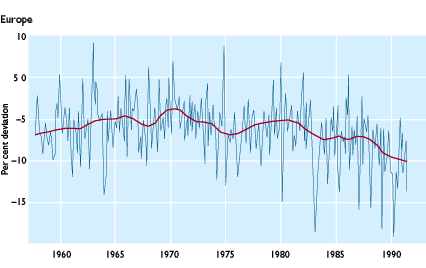
Changes in average ozone concentrations in Europe
(WMO)
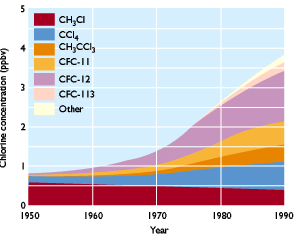
Calculated atmospheric clorine concentrations
between 1950 and 1990 (RIVM)
- ozone concentrations have declined at
mid-latitudes over Europe by 6-7% during the past decade
- Europe contributes about one-third of global
annual emissions of ozone-depleting substances
- skin cancer deaths due to increased UV-B
radiation are expected to reach two per million inhabitants by the year
2030
- even if the London Protocol to the Vienna
Convention is fully implemented, it will be at least 70 years before
ozone depletion stops
29 The loss of biodiversity
Reviews the extent of biological diversity in
Europe, and the reasons for its decline on a continent where human
influence are particularly pervasive. The chapter outlines a series of
goals that should lead to the conservation of biodiversity an the
sustainable use of biological resources, and strategies fm achieving
these goals, including implementation of the Convention on
Biodiversity.
- European ecosystems include more than 2 500
habitat types and some 215 000 species, of which 90% are
invertebrates
- almost every European country has endemic
species (that are found nowhere else)
- European centres of biodiversity include the
Mediterranean Basin and the Caucasus Mountains on the southeastern
margin of Europe
- since the ecological roles of many species are
largely unknown, the wisest course is to adopt the precautionary
principle of avoiding any actions that needlessly reduce
biodiversity
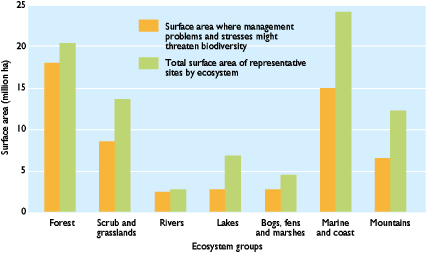 |
Representative site of natural European
ecosystem groups: aggregated total area, and area where management
problems and stress. pose potential threat to
biodiversity |
30 Major accidents
Reviews the environmental problems caused by accidents an the
attention that has been given to trying to set acceptable risk levels,
for both human health and the environment. Risk management is analysed,
focusing on the magnitude of the probability that it will occur. The
consequences of an accident and the need for industry to assess its own
risks and to u integrated safety management systems and audit tools is
discussed. Emergency response or contingency plans are discussed in
both national and transboundary situations. The chapter concludes with
a special section on the causes o nuclear accidents, and strategies for
avoiding them.
- the availability of accident statistics is a
key factor improving the capability to reduce risks through safety
management
- goal setting requires identifying acceptable
risk levels: in the Netherlands, for example, processes that have a
probability of causing ten deaths more frequently than once every 100
000 years are considered unacceptable
- the specific problems of nuclear safety in
Central and Eastern Europe are being tackled by a strategy of
assistance by 24 countries
31 Acidification
Combustion of fossil fuels emits sulphur and nitrogen dioxides into
the atmosphere where the gases are converted into acids which, after
deposition, lead to a series of undesired changes in terrestrial and
aquatic ecosystems. The chapter focuses on the adverse chemical and
biological effects found in lakes, soils and forests as a result of
deposition of acidifying substances in amounts exceeding critical
loads. Possibilities for reducing emissions through international
agreements are discussed.
- severe acidification of freshwater is
occurring over large areas of southern Scandinavia, causing widespread
fish kills
- coniferous forests are being damaged in the
Czech Republic, Germany, Poland and the Slovak Republic probably as a
result of acidification and high concentrations of ozone and sulphur
dioxide in the air
- acid deposition is expected to decrease in
Europe following emission reductions but in more than half the area,
critical loads will still be exceeded
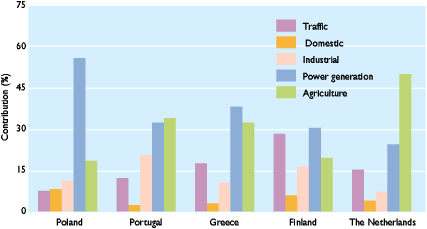
Relative comparison of source categories to potential acid
deposition, 1990 (RIVM)
32 Tropospheric ozone and other photochemical
oxidants
Reviews the complex reactions that occur in the lower atmosphere
producing oxidants such as ozone from the main precursors - nitrogen
oxides, volatile organic compounds, methane and carbon monoxide. Levels
of these oxidants are increasing, and are having adverse effects on
human health. They can also affect materials such as paint and
plastics, crop and possibly forests. In the northern hemisphere ozone
concentrations are expected to keep rising at 1% a year. No limiting
goals have yet been set and the actions already undertaken are not
thought to be sufficient in Europe.
-
WHO Air Quality Guidelines for ozone are
frequently exceeded in most parts of Europe
-
there is no chemical in the atmosphere where
the difference between actual and toxic levels is as marginal as that
for ozone
-
at ground level, photochemical oxidants
including ozone, can cause premature ageing of the lungs, eye, nose and
throat irritation, chest discomfort, coughs and headaches
33 The management of freshwater
resources
 |
|
-
water pollution and
deterioration of aquatic habitats are severely hampering the use of
water for human consumption and wildlife
-
much water is lost
in the distribution system and although 25-30% losses are estimated for
France, the United Kingdom and Spain, the figure may reach
50_N
-
regarding water as
an economic good could benefit water management through appropriate
pricing
|
| European water demand, 1950 - 2000 |
The regional distribution of problems concerning European water
resource - such as the imbalance of water availability and demand, the
destruction of aquatic habitats, and water pollution - is highlighted
and discussed in relation to the pressures arising from human
activities in the catchment areas. A series of sustainable goals for
water resource management has been proposed, along with the means of
reaching them. Particular attention is devoted to the necessity of
international cooperation for management of transboundary rivers.
34 Forest degradation
This chapter focuses on the two most important causes of forest
degradation across Europe: air pollution, which seriously threatens the
sustainability of forest resources in Central, Eastern and, to a lesser
extent, Northern Europe; al fire, a major concern in Southern Europe.
The analysis of the, damage is derived from large-scale spatial
observations of European-wide surveys. However, they do not readily
permit cause-effect relationships to be identified. Detailed monitoring
could improve understanding. For fires, causes are often related to
socioeconomic factors which render the control o the causes complex
since they often indicate conflicts and tensions in the overall system
of land management.
- a 1992 survey of 113 tree species in 34
European countries showed that 24% of trees were damaged in that
defoliation exceeded 25%; 10% of trees were suffering from
discoloration
- as much as 54% of the forests of the Czech
Republic may have suffered irreversible damage
- an average of 700 000 ha of wooded land are
burnt each year by a total of 60 000 fires in Europe

Average annual number of forest fires 1989-91 (Ministerial
Conference of Helsinki)
35 Coastal zone threats
and management
Highlights the importance of coastal zones as a buffer between the
land and the sea, and examines how human activities creating physical
modifications of the coastline and emissions of contaminants have led
to the deterioration of habitats and water quality. In order to
alleviate the serious environmental problems found in many coastal
areas, a strategy for integrated coastal zone management has been
proposed. This strategy takes into account the importance of coasts for
human well-being and, at the same time, provides the habitats that
plants and animals require.
- the European coastline, which is at least 148
000 km long, has an estimated 200 million people living within so km of
it
- marine pollution of the coastal zone is a
serious problem in all of Europe's seas
- no comprehensive coastal zone management
scheme yet exists for Europe
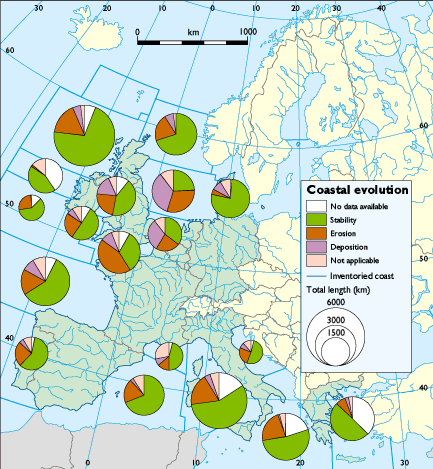 |
Coastal evolution in the
EU(1991) |
| |
36 Waste production and management
Analyses the increasingly
severe problem of waste disposal and processing caused by steady
increases in both the quantity of wastes and in their toxic component.
Despite increased emphasis on waste prevention and recycling, most
European waste is disposed of by landfill and incineration. Waste
control options are discussed, pointing out that in spite of progress
achieved most waste still escapes control or avoids strict regulations
by transfrontier movement across European countries or to developing
ones. Strategies to minimize waste generation and ensure safe
management are seen as crucial to move towards sustainable patterns of
production and consumption.

Waste disposal costs (in $/tonne)
- Europe produces more than 250 million tonnes
of municipal waste and more than 850 million tonnes of industrial waste
annually
- in the OECD countries of Europe there are 10
000 annual transfrontier movements, totalling 2 million tonnes, of
hazardous waste
- more than 55 000 contaminated sites have been
registered in just six European countries, and the total contaminated
area in Europe is estimated to be between 47 000 and 95 000 km2
including 1000-3000 km2 of contamination from landfill
37 Urban
stress
Urban areas in Europe show increasing signs
of environmental stress, notably in the form of poor air quality,
excessive noise and traffic congestion. On the other hand cities absorb
increasing amounts of resources and produce increasing amounts of
emissions and waste. This chapter analyses the causes of urban stress
and their link to the rapid changes in urban lifestyles and patterns of
urban development which have occurred in the last few decades. A series
of goals and means to achieve sustainable urban patterns in Europe are
discussed including: improved urban planning; integrated transport
management; efficient use of water, energy and materials; the setting
of new standards and improvement of information.
- urban traffic is an increasingly important
source of air pollution causing most of the summer smog in European
cities and the exceeding WHO Air Quality Guidelines for ozone, nitrogen
oxides and carbon monoxide
- urban transport accounts for about 30% of
total energy use in most cities and a shift has occurred towards the
use of the car which fulfils more than 80% of total mechanized
transport
- a Charter of European Cities and Towns Towards
Sustainability was signed by 80 local authorities in May 1994 at
Aalborg, Denmark
38 Chemical
risk
Few environmental problems in Europe cannot
be traced back to some form of excessive chemical loading, and this
chapter reviews the problems this causes and the ways of reducing the
danger. The goal is to reduce levels of chemicals in the environment to
a target, low-risk level where only negligible harmful effects occur to
both the population and the environment. The EU has adopted a
far-reaching programme designed to reduce risks from chemicals in the
environment.
- more than 10 million chemical compounds have
been identified, of which about 100 000 are produced
commercially
- during June 1993 to June 1994 an EU programme
completed the assessment of 1 700 chemicals produced or imported in
amounts of more than 1 000 tonnes a year
- Progressive achievement of reduced chemical
risk to the environment (Dutch Ministry of Housing, Physical Planning
and Environment)
|
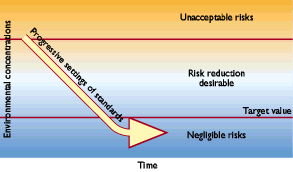
|
Progressive achievement of reduced
chemical risk to the environment (Dutch Ministry of Housing, Physical
Planning and Environment) |











Document Actions
Share with others